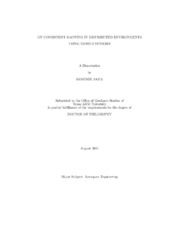| dc.contributor.advisor | Chakravorty, Suman | |
| dc.creator | Saha, Roshmik | |
| dc.date.accessioned | 2011-10-21T22:03:41Z | |
| dc.date.accessioned | 2011-10-22T07:12:49Z | |
| dc.date.available | 2011-10-21T22:03:41Z | |
| dc.date.available | 2011-10-22T07:12:49Z | |
| dc.date.created | 2011-08 | |
| dc.date.issued | 2011-10-21 | |
| dc.date.submitted | August 2011 | |
| dc.identifier.uri | https://hdl.handle.net/1969.1/ETD-TAMU-2011-08-9718 | |
| dc.description.abstract | The problem of robotic mapping, also known as simultaneous localization and mapping (SLAM), by a mobile agent for large distributed environments is addressed in this dissertation. This has sometimes been referred to as the holy grail in the robotics community, and is the stepping stone towards making a robot completely autonomous. A hybrid solution to the SLAM problem is proposed based on "first localize then map" principle. It is provably consistent and has great potential for real time application. It provides significant improvements over state-of-the-art Bayesian approaches by reducing the computational complexity of the SLAM problem without sacrificing consistency. The localization is achieved using a feature based extended Kalman filter (EKF) which utilizes a sparse set of reliable features. The common issues of data association, loop closure and computational cost of EKF based methods are kept tractable owing to the sparsity of the feature set. A novel frequentist mapping technique is proposed for estimating the dense part of the environment using the sensor observations. Given the pose estimate of the robot, this technique can consistently map the surrounding environment. The technique has linear time complexity in map components and for the case of bounded sensor noise, it is shown that the frequentist mapping technique has constant time complexity which makes it capable of estimating large distributed environments in real time. The frequentist mapping technique is a stochastic approximation algorithm and is shown to converge to the true map probabilities almost surely. The Hybrid SLAM software is developed in the C-language and is capable of handling real experimental data as well as simulations. The Hybrid SLAM technique is shown to perform well in simulations, experiments with an iRobot Create, and on standard datasets from the Robotics Data Set Repository, known as Radish. It is demonstrated that the Hybrid SLAM technique can successfully map large complex data sets in an order of magnitude less time than the time taken by the robot to acquire the data. It has low system requirements and has the potential to run on-board a robot to estimate large distributed environments in real time. | en |
| dc.format.mimetype | application/pdf | |
| dc.language.iso | en_US | |
| dc.subject | SLAM | en |
| dc.subject | Mapping | en |
| dc.subject | Stochastic Approximation | en |
| dc.title | On Consistent Mapping in Distributed Environments using Mobile Sensors | en |
| dc.type | Thesis | en |
| thesis.degree.department | Aerospace Engineering | en |
| thesis.degree.discipline | Aerospace Engineering | en |
| thesis.degree.grantor | Texas A&M University | en |
| thesis.degree.name | Doctor of Philosophy | en |
| thesis.degree.level | Doctoral | en |
| dc.contributor.committeeMember | Bhattacharya, Raktim | |
| dc.contributor.committeeMember | Amato, Nancy | |
| dc.contributor.committeeMember | Junkins, John L. | |
| dc.contributor.committeeMember | Datta, Aniruddha | |
| dc.type.genre | thesis | en |
| dc.type.material | text | en |


